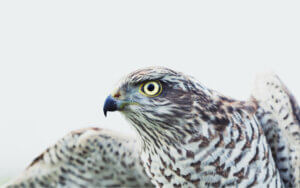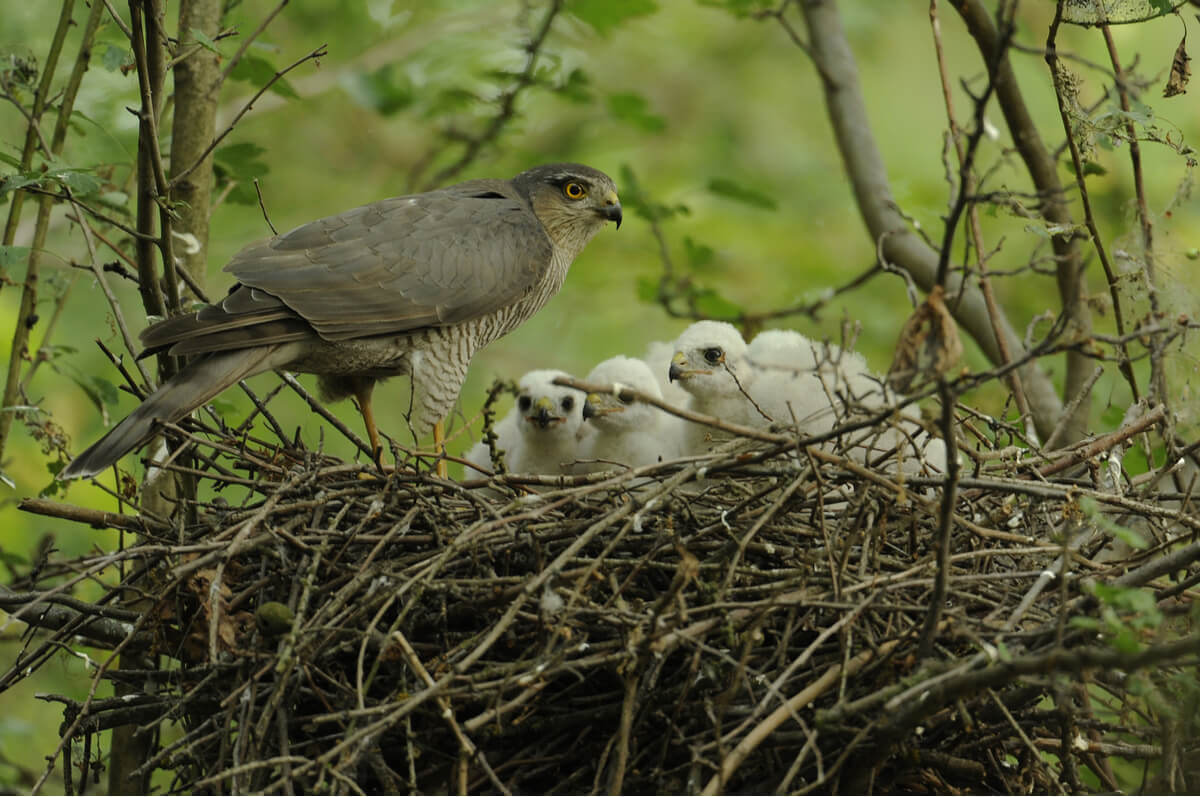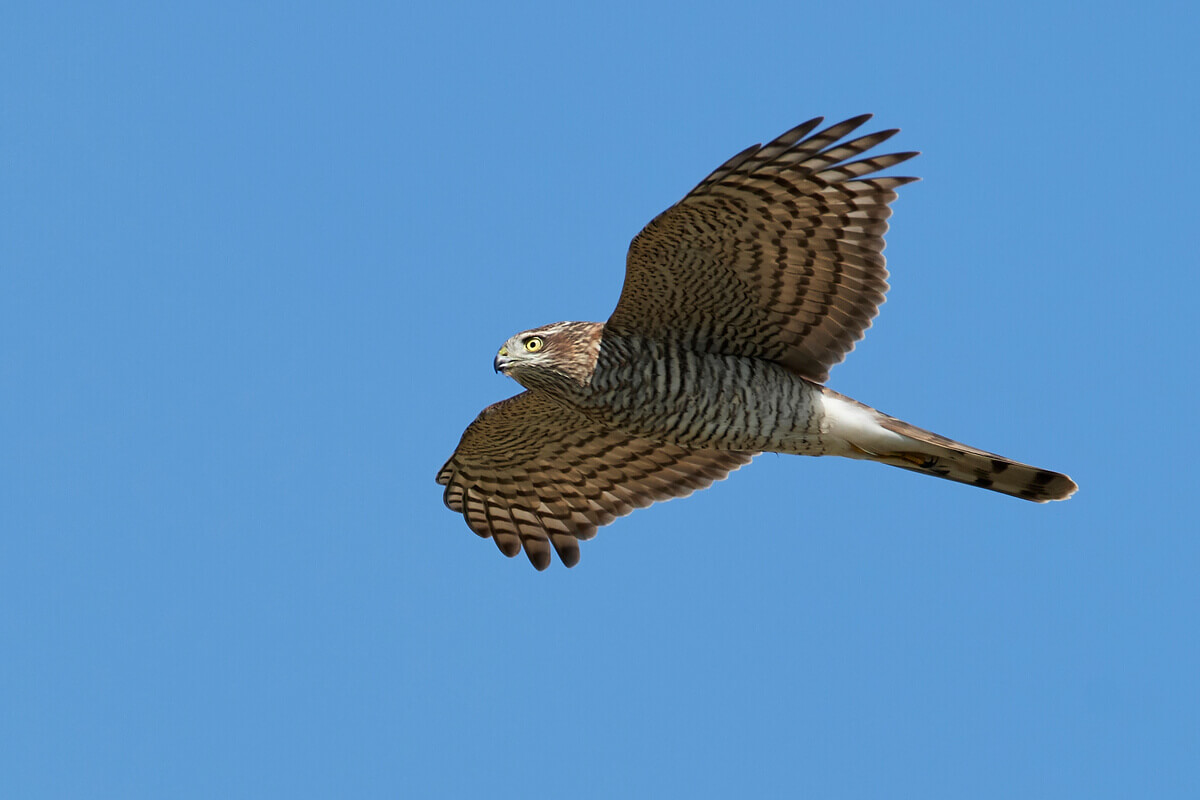4 Interesting Facts About the Eurasian Sparrowhawk


Written and verified by the biologist Ana Díaz Maqueda
The Eurasian sparrowhawk (Accipiter nisus) is a medium-sized species of hawk that’s similar in pigmentation to the Northern goshawk. This animal is common in falconry thanks to its fast flight, but it can’t hunt large prey.
This species is totally specialized in hunting small birds (Passeriformes) that hide in the forests. The great agility of the Eurasian sparrowhawk to move in this terrain makes it an infallible predator. Do you want to know more about this daytime bird of prey? Keep reading!
1. A very monogamous bird only if it reproduces
The Eurasian sparrowhawk may not be a 100% monogamous bird. Sometimes in the life of the sparrowhawk there may be situations where one member of the pair disappears, for whatever reason.
According to studies, every year, established sparrowhawk pairs remain steady, as long as the richness of their territory is maintained. If the prey is scarce, both partners look for a new territory nearby in which to settle together and build the nest.
The main reason why a pair of hawks separates is because of the lack of offspring. First, when a pair fails to have chicks, the first thing they do is change territory.
If the following year the couple also fails to conceive, it’s usually the female that goes in search of a new territory and a new partner. The male tends to stay in the old territory and look for a new female to reproduce with there.

2. Speed of flight of the Eurasian sparrowhawk
The Eurasian sparrowhawk isn’t one of the fastest birds of prey, as it’s outpaced by birds such as the peregrine falcon (Falco peregrinus), which can travel at up to 240 miles per hour. However, the 75 miles per hour that sparrowhawks can reach are nothing to laugh at.
Like all birds of the Falconidae family, these animals are extremely fast and agile in flight. Their capacity makes them skillful predators of small, fast prey.
3. They select sick prey
We know that weaker and sicker animals are easier prey in nature. If a mammal limps, a bird flies poorly or demonstrates changes in its behavior that expose it more to predation, it’s very likely that it’ll be hunted rather than a healthy and strong animal. However, this isn’t always the case, as healthy animals are also often preyed upon.
Sparrowhawks feed mainly on passerines or songbirds. In addition, there’s a marked difference in the diet of the female and male Eurasian sparrowhawk. They hunt birds that weigh between 1.4 to 1.8 ounces. At most, they may hunt birds weighing up to 4.25 ounces. Their favorite prey are finches, sparrows, and great tits.
On the other hand, females have a predilection for larger prey. In general, the average weight of the birds hunted by a female sparrowhawk is between 1.75 and 2.5 ounces, but they’re able to capture animals weighing up to a little over a pound.
The most interesting thing about this is that, according to one study, these birds are able to select prey infected with blood parasites, such as Leucocytozoon or malaria. Infected birds are 16 to 25% more likely to be caught than those that aren’t.
4. Sexual dimorphism of the common sparrowhawk
Male and female Common Sparrowhawks can be easily differentiated, as they have a very marked sexual dimorphism. Males have a more grayish general coloring, while females are browner.
However, the most striking feature of the species is the difference in size. The fact that females eat more isn’t because they’re greedy, but because they’re twice the size of the male and weigh twice as much.
There’s a simple explanation for this. Generally, the females of any species of raptor spend more time protecting the nest and their chicks, although the upbringing is usually shared. Therefore, females need to be larger and stronger to be able to actively defend their entire territory, as well as their offspring.

As you’ve seen, the Eurasian sparrowhawk is a faithful bird of prey as long as it manages to reproduce with its partner. Besides this interesting fact, it’s also a fast bird, with the capacity to reduce parasitism among its prey in an indirect way and, with it, improve its populations.
The Eurasian sparrowhawk (Accipiter nisus) is a medium-sized species of hawk that’s similar in pigmentation to the Northern goshawk. This animal is common in falconry thanks to its fast flight, but it can’t hunt large prey.
This species is totally specialized in hunting small birds (Passeriformes) that hide in the forests. The great agility of the Eurasian sparrowhawk to move in this terrain makes it an infallible predator. Do you want to know more about this daytime bird of prey? Keep reading!
1. A very monogamous bird only if it reproduces
The Eurasian sparrowhawk may not be a 100% monogamous bird. Sometimes in the life of the sparrowhawk there may be situations where one member of the pair disappears, for whatever reason.
According to studies, every year, established sparrowhawk pairs remain steady, as long as the richness of their territory is maintained. If the prey is scarce, both partners look for a new territory nearby in which to settle together and build the nest.
The main reason why a pair of hawks separates is because of the lack of offspring. First, when a pair fails to have chicks, the first thing they do is change territory.
If the following year the couple also fails to conceive, it’s usually the female that goes in search of a new territory and a new partner. The male tends to stay in the old territory and look for a new female to reproduce with there.

2. Speed of flight of the Eurasian sparrowhawk
The Eurasian sparrowhawk isn’t one of the fastest birds of prey, as it’s outpaced by birds such as the peregrine falcon (Falco peregrinus), which can travel at up to 240 miles per hour. However, the 75 miles per hour that sparrowhawks can reach are nothing to laugh at.
Like all birds of the Falconidae family, these animals are extremely fast and agile in flight. Their capacity makes them skillful predators of small, fast prey.
3. They select sick prey
We know that weaker and sicker animals are easier prey in nature. If a mammal limps, a bird flies poorly or demonstrates changes in its behavior that expose it more to predation, it’s very likely that it’ll be hunted rather than a healthy and strong animal. However, this isn’t always the case, as healthy animals are also often preyed upon.
Sparrowhawks feed mainly on passerines or songbirds. In addition, there’s a marked difference in the diet of the female and male Eurasian sparrowhawk. They hunt birds that weigh between 1.4 to 1.8 ounces. At most, they may hunt birds weighing up to 4.25 ounces. Their favorite prey are finches, sparrows, and great tits.
On the other hand, females have a predilection for larger prey. In general, the average weight of the birds hunted by a female sparrowhawk is between 1.75 and 2.5 ounces, but they’re able to capture animals weighing up to a little over a pound.
The most interesting thing about this is that, according to one study, these birds are able to select prey infected with blood parasites, such as Leucocytozoon or malaria. Infected birds are 16 to 25% more likely to be caught than those that aren’t.
4. Sexual dimorphism of the common sparrowhawk
Male and female Common Sparrowhawks can be easily differentiated, as they have a very marked sexual dimorphism. Males have a more grayish general coloring, while females are browner.
However, the most striking feature of the species is the difference in size. The fact that females eat more isn’t because they’re greedy, but because they’re twice the size of the male and weigh twice as much.
There’s a simple explanation for this. Generally, the females of any species of raptor spend more time protecting the nest and their chicks, although the upbringing is usually shared. Therefore, females need to be larger and stronger to be able to actively defend their entire territory, as well as their offspring.

As you’ve seen, the Eurasian sparrowhawk is a faithful bird of prey as long as it manages to reproduce with its partner. Besides this interesting fact, it’s also a fast bird, with the capacity to reduce parasitism among its prey in an indirect way and, with it, improve its populations.
All cited sources were thoroughly reviewed by our team to ensure their quality, reliability, currency, and validity. The bibliography of this article was considered reliable and of academic or scientific accuracy.
- BirdLife International. 2016. Accipiter nisus. The IUCN Red List of Threatened Species 2016: e.T22695624A93519953.
- Newton, I., & Marquiss, M. (1982). Fidelity to breeding area and mate in sparrowhawks Accipiter nisus. The Journal of Animal Ecology, 327-341.
- Trowbridge, C. C. (1895). Hawk flights in Connecticut. The Auk, 12(3), 259-270.
This text is provided for informational purposes only and does not replace consultation with a professional. If in doubt, consult your specialist.








